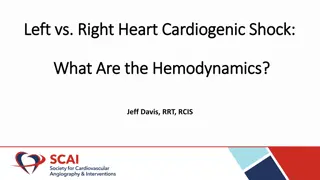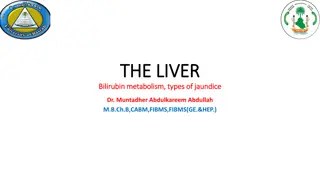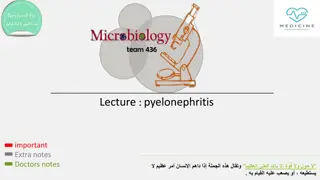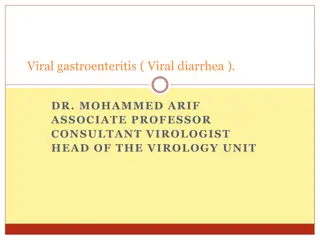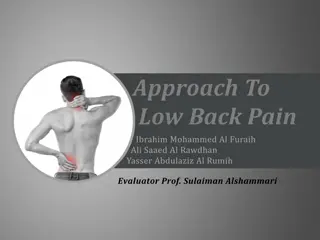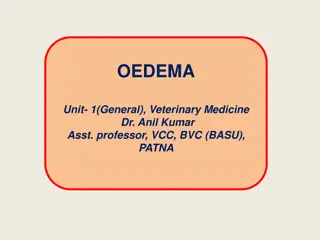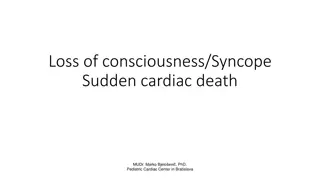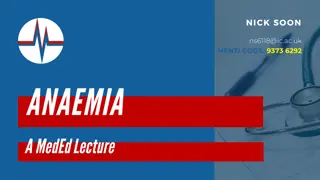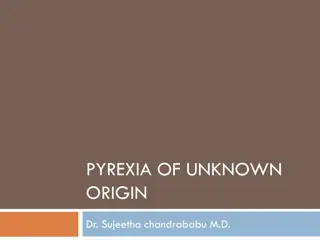A New Paradigm for Spasticity Management
New approach to managing spasticity, a disorder characterized by increased muscle tone and exaggerated tendon jerks. The author, Dr. Darryl Kaelin, explores the benefits of this new paradigm and its potential impact on motor control. The article also includes information on the etiologies and preval
1 views • 39 slides
Pulmonary and Critical Care Lecture Highlights: Bronchiectasis and Sarcoidosis Overview
Dive into the realm of pulmonary and critical care as Dr. Michael Forte discusses the intricacies of bronchiectasis and sarcoidosis. Understand the etiologies, diagnosis, investigations, and treatment options for these respiratory conditions. Explore the challenges and nuances of managing patients w
0 views • 35 slides
Understanding Hemodynamics in Left vs. Right Heart and Cardiogenic Shock
Explore the hemodynamic differences between the left and right heart, the etiologies of cardiogenic shock, and the importance of right heart catheterization in managing this critical condition. Learn about key parameters such as PCWP, RAP, CO, and more that play a crucial role in assessing cardiac f
1 views • 14 slides
Mystery Case Study: 75-Year-Old Male with Fever and Altered Mental Status
A 75-year-old male with a history of multiple animal exposures presented with fever, altered mental status, headache, and diarrhea. Physical exam revealed vital signs within normal limits, and labs showed various results including negative infectious disease workup but pending further tests. Imaging
0 views • 11 slides
Understanding Bilirubin Metabolism and Different Types of Jaundice
Explore the detailed information about bilirubin metabolism and various types of jaundice, including their clinical presentations, etiologies, and management strategies. Learn to differentiate between different types of jaundice based on case scenarios and understand the functional anatomy and physi
1 views • 33 slides
Understanding Pyelonephritis: Key Insights and Management
Pyelonephritis is a serious bacterial infection of the kidneys, leading to renal damage and potentially life-threatening complications. This condition has different etiologies, including ascending bacterial infection and hematogenous spread, with Escherichia coli being the most common causative orga
1 views • 22 slides
Anesthesia in Pediatric Epiglottitis: Update 2019
Infectious and non-infectious etiologies of epiglottitis, along with epidemiology, signs, symptoms, and differential diagnosis are explained in this comprehensive guide. Anesthetic techniques and antibiotic regimens for treating pediatric patients with epiglottitis are detailed, aiding in the identi
3 views • 22 slides
Viral Specimen Selection and Collection Overview
Specimen selection for viral testing depends on the suspected viral etiologies and disease syndrome. Throat and nasopharyngeal swabs are used for different viruses, while rectal swabs, urine, blood, and tissue samples are also collected for specific viral detection. Proper specimen transport and sto
0 views • 7 slides
Understanding Viral Gastroenteritis: Causes, Symptoms, and Transmission
Viral gastroenteritis, commonly known as viral diarrhea, is a prevalent infection affecting mainly infants and young children. The disease is self-limiting, with symptoms like diarrhea, vomiting, and abdominal pain. Key viral etiologies include Rota viruses, Astroviruses, Norovirus, and Enteric aden
0 views • 19 slides
Approach to Low Back Pain Evaluation and Management
Low back pain evaluation and management involve understanding common causes, risk factors, diagnostic methods, and appropriate interventions. Red flags, such as history of cancer, are crucial in assessment. Imaging studies like MRI may be necessary based on symptoms. Differentiating between mechanic
0 views • 67 slides
Understanding Stroke-Specific Etiologies and Interventions for Falls in Inpatient Rehabilitation
Falls are a common complication after stroke, leading to hip fractures and various secondary complications. Inpatient rehabilitation often focuses on interventions to reduce stroke-related falls, considering factors like muscle tone, cognitive impairments, and balance deficits. Understanding these s
1 views • 27 slides
Management of Hypoglycemic Disorders: Evaluation and Guidelines
Hypoglycemia can present with various etiologies, including insulinoma, NIPHS, and antibody-related disorders. Diagnosis relies on clinical evaluation and specialized tests. Treatment may involve partial pancreatectomy or exclusion of surreptitious causes. Guidelines emphasize the importance of thor
0 views • 21 slides
Understanding Edema in Veterinary Medicine
Edema, an excessive accumulation of fluid in tissue spaces, is caused by disruptions in fluid exchange mechanisms. It can result from various factors such as increased hydrostatic pressure, decreased plasma oncotic pressure, increased capillary permeability, and obstruction to lymphatic flow. Differ
0 views • 10 slides
Case Study: A New Kid on the Block - Pediatric Presentation
An 11-year-old girl presented with a four-month history of fever, three months of generalized weakness and body ache, and a recent weight loss. Physical examination revealed pallor, edema, generalized tenderness, lymphadenopathy, and telangiectatic rash. Vitals showed elevated respiratory and heart
0 views • 27 slides
Understanding Hallux Rigidus: Anatomy, Biomechanics, and Epidemiology
Hallux rigidus is a condition characterized by the loss of motion in the first metatarsophalangeal joint, primarily in adults, due to degenerative arthritis and osteophyte formation. This article delves into the anatomy, biomechanics, epidemiology, and etiologies of hallux rigidus, shedding light on
0 views • 23 slides
Understanding Lower Back Pain: Epidemiology, Etiologies, and Management
Explore the epidemiology, etiologies, clinical course, and management approaches for lower back pain. Gain insights into the clinical approach, physical examination, workup, and effective management strategies for this common condition.
0 views • 54 slides
Understanding Loss of Consciousness and Sudden Cardiac Death in Children
Loss of consciousness, including syncope and sudden cardiac death, is a significant concern in pediatric patients. The epidemiology shows that approximately 25% of children experience at least one episode of loss of consciousness before the age of 19, with girls visiting pediatricians more than boys
0 views • 5 slides
Understanding Anemia: Causes, Symptoms, and Diagnosis
Anemia is a condition characterized by low red blood cell count, leading to symptoms like fatigue, pale skin, and shortness of breath. Causes range from nutritional deficiencies to chronic diseases. Diagnosis involves blood tests and examination of red blood cells. This content delves into various t
0 views • 52 slides
Understanding Acute Visual Loss: Causes and Evaluation
Loss of vision can occur suddenly, affecting one or both eyes and various parts of the visual field. This guide explores the definition, pathophysiology, and evaluation of acute visual loss. Common causes include optic nerve diseases, retinal disorders, and vascular issues. The visual pathway from t
0 views • 37 slides
Understanding Pyrexia of Unknown Origin: Causes and Classification
Pyrexia of unknown origin (PUO) is a challenging diagnostic scenario characterized by persistent fever without an identified cause. Dr. Sujeetha Chandrababu M.D. defined PUO as temperatures exceeding 38.3°C for several weeks with no definitive diagnosis. Classification of PUO includes various categ
0 views • 43 slides


